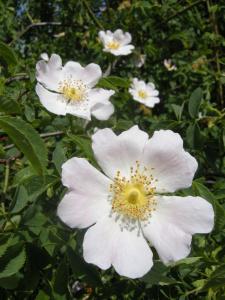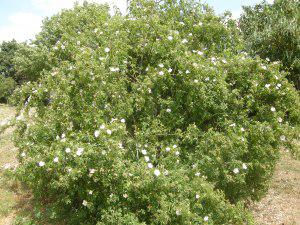
Rosa canina flower (21/05/2011, London)
Position: Thrives in full sun
Soil: Moist and well drained.
Flowering period: Early summer.
Eventual Height: 4m (taller with support)
Eventual Spread: Indefinite
Hardiness: USDA Zone 3a-9b
Family: Rosaceae
Rosa canina is a deciduous shrub with a rambling and scrambling habit. Its spiny (modified leaves) stems bear pinnate leaves, composed of 5 to 7 dark green leaflets with serrated margins. Its early summer fragrant hermaphrodite flowers have five petals and can vary between deep pink and white. Following on from the flower in autumn scarlet red fruit 15mm-20mm long are produced, commonly known as hips. These are edible and rich in vitamin C. This plant spreads by suckers.
R. canina, commonly known as Dog Rose is native to north west Africa, western Asia and Europe, including England. It was used in the 18th and 19th centuries, among other things, to treat the bite of a rabid dog. The hips are still used in herbal medicine today and are believed to treat bladder and kidney disorders. It was an invaluable source of vitamin C during the world wars and continues to be used to make syrup, jellies and other preserves to this day. A commercial soft drink called Cockta is still produced in Slovenia which uses Dog Rose as one of its flavorings.
Rosa is the ancient Latin term for the rose. Canina is also from the Latin, meaning ‘dog like’, this may refer to this rose being inferior to the cultivated garden roses or it may refer to the use of this rose in the treating of rabid dog bite.

Rosa canina (21/05/2011, London)
The Landscape architect may find this shrub useful in many naturalistic applications where native planting is essential. It may be used as part of a native woodland mix forming one of the components of the understory and will be found at the woodland edge once mature. This plant can also from an important component of a native mixed hedge or used on its own to form an impressive, impenetrable native hedge.
This plant will tolerate almost any soil conditions; it will be happy in acid, neutral or alkaline pH levels, in loam, sand, clay or chalk in a sheltered or exposed location facing any aspect.
Ecologically this plant will attract many pollinating insects such as honey bees and its fruit will attract birds and other foraging animals. The fruit are eaten by birds and mammals.
Maintenance: Little maintenance required if grown in a naturalistic environment. If the plant needs to be restricted due to climbing trees or spreading where it is not wanted or is being maintained as a hedge, it may be pruned in late Autumn or winter.

